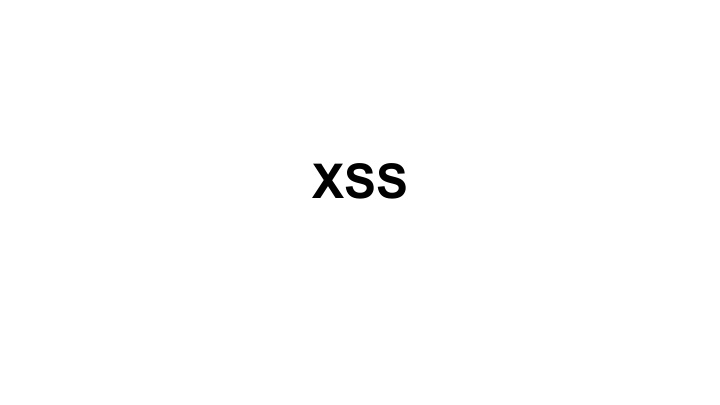



XSS
Real-life XSS examples
fotolog.com xssed mirror http://m.fotolog.com/search.php?auth=%3Ch1%3ERME% 20Pwnea%20de%20Nuevo%3C/h1%3E%3Cscript%3E alert%28document.cookie%29%3C/script%3E% 3Cnoscript%3E URL decoder
Decoded -- cleaned up a bit http://m.fotolog.com/search.php?auth= <h1> RME Pwnea de Nuevo </h1> <script> alert(document.cookie) </script><noscript>
xfinity.comcast.net xssed mirror http://xfinity.comcast.net/news/national/%27% 3C/script%3E%3Cscript%3Ealert%28 String.fromCharCode%2888,83,83%29%29% 3C/script%3E/
Decoded -- cleaned up a bit http://xfinity.comcast.net/news/national/' </script> <script> alert(String.fromCharCode(88,83,83)) </script>/
bankaustria.at xssed mirror jpg http://www.bankaustria.at/privatkunden-kontaktformular.jsp?id=%22%3E%3CScRiPt%3Ealert%28%27dhony%27% 29%3C%2FsCrIpT%3E%22%3E%3Ccenter%3E%3Ch1%3Edhonywidyantoro+-+VISIT+US+ON+FACEBOOK+% 3D+https%3A%2F%2F www.facebook.com%2FDokterDhonyW%3C%2Fh1%3E%3Cimg%20 src=%22http://betadhony.files.wordpress.com/2014/01/1488076_638621169510722_147500364_n1.jpg%22%20 alt=%22http://betadhony.files.wordpress.com/2014/01/1488076_638621169510722_147500364_n1.jpg%22%20 width=%22700%22%20height=%22700%22%3E%3C%2Fa%3E%3E%3C %2Fmarquee%3E
Review : 3 types of XSS attacks Reflected ● Attacker sends malicious script in legit page ● Browser assumes it’s legit and executes it ● Reflected to user as part of victim site’s page Stored ● attack stores malicious script in app, gets returned in later request
Review : 3 types of XSS attacks DOM-based ● app uses client-side javascript ● DOM is modified but change may never reach web app server ● HTML source code/ HTML response are unchanged DOM : defines tree structure for document for easy access
A Key Difference... In regular XSS ● Load page that contains malicious content. Execution of bad script on page load. In DOM-based XSS ● Load legitimate page that uses user input. Legitimate JavaScript takes user input that is dangerous.
A client-side problem! Many websites need to update without refreshing the whole page (that ‘flicker effect’). Often done with JavaScript on the client-side.
Hiding DOM-based XSS from the Server ● use of URL fragment identifier http://www.example.com/test.html#<script>alert(1)</script> ○ ○ Anything after ‘#” in URL is not sent to the server ● Access from client-side, but not server-side ● New HTML5 features LocalStorage and IndexedDB are also invisible to server
jQuery jQuery ● JavaScript library designed for easy HTML traversal, DOM manipulation, AJAX request handling etc. $(‘some selector name’) ● creates a jQuery object for selected element ● a way of matching elements in a document
jQuery XSS demo Demo credit to: Himanshu Upadya jquery_example.html Other jQuery sinks
But what about Chrome anti-XSS filter? Example by Nikifor ● original site ● Simple HTML injection ● simple XSS (caught by anti-XSS filter!) ● removing end script tag ● bypass! ● redirection!
Sanitizers What is HTML Sanitization? What should be sanitized?
Sanitizers What is HTML Sanitization? ● Based on some sanitization policy, remove dangerous HTML markup that might introduce JavaScript and a XSS attack What should be sanitized?
Sanitizers What is HTML Sanitization? ● Based on some sanitization policy, remove dangerous HTML markup that might introduce JavaScript and a XSS attack What should be sanitized? ● sanitize user input!!
Quick Note... Validator ● checks that user input is an expected format Sanitizer ● checks that user input is clean Escaper ● converting special characters so browser interprets as text, not code
Sanitization Policy Whitelist ● list of known good inputs Blacklist ● list of known bad inputs Would it be better to use a whitelist or a blacklist? Why do you think so?
Some sources used ● http://www.chmag.in/article/aug2010/advance-xss- attacks-dom-based ● http://excess-xss.com/ ● https://eamann.com/tech/jquery-xss/ ● http://www.breakthesecurity.com/2012/05/dom-based- cross-site-scriptingxss.html
Recommend
More recommend